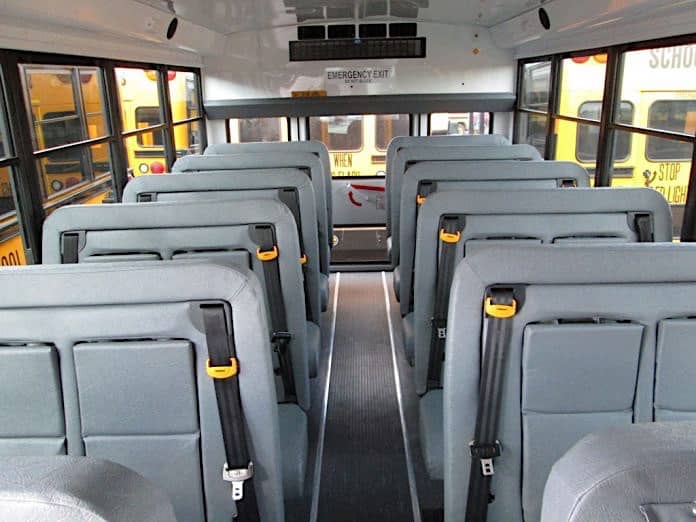The “Making the Grade” segment produced for PBS by Education Week that aired May 16 dove into the murky waters of three-point, lap-shoulder restraint systems. If you have yet to watch it, check it out. If you have already seen it, take a another look, and read our account starting on page 30 of the June magazine issue.
 No matter where you fall on the debate spectrum, it is hard to argue that the segment wasn’t as nuanced and balanced as we’ve seen the mainstream media handle one of the most nuanced student transportation issues, and in just under 7 minutes no less. More on that in a bit.
No matter where you fall on the debate spectrum, it is hard to argue that the segment wasn’t as nuanced and balanced as we’ve seen the mainstream media handle one of the most nuanced student transportation issues, and in just under 7 minutes no less. More on that in a bit.
Proponents were buoyed by the demonstration of crash test videos that show how lap-shoulder belts provide the most complete passenger protection in various crash scenarios. Opponents were encouraged by Education Week correspondent Lisa Stark, a veteran television journalist of ABC News fame, discussing the challenges of requiring students to wear the restraints and, more importantly, the indelible price tag to districts. Making that very point was Todd Watkins, director of transportation for Montgomery County Public Schools in Maryland.
Watkins, a 21-year industry veteran with an additional dozen years of shuttle transportation and commercial vehicle safety experience with the University of Maryland, is as professional and knowledgeable as they come. There is absolutely no doubt in my mind that he spoke from the heart when he told her that he can’t justify the $1-million cost per year of adding seat belts to the district’s school buses. And, yes, he added, that is an extremely tough sell to parents. But he’s a true believer, as he should be, that school buses are the safest vehicle, bar none, and his budget is better spent on other areas of student safety.
As Stark reported, in all those years at Montgomery County Watkins and his team have never suffered a fatal school bus crash. By the grace of God, one might respond. True, none of us should ever be so self-confident to utter aloud the words, “That would never happen to me,” which can be a literal kiss of death for student transporters. But the truth of the matter is that student transporters make extremely difficult decisions every day when presented with limited funds and a laundry list of growing needs.
For all the reasons that the industry has volleyed back and forth for decades, one could argue that “Making the Grade” omitted very real fears about what effect occupant restraint systems might have on emergency evacuations or reduced passenger capacity. I asked Stark this very question.
Now remember, Stark and her team whittled down this extremely complex issue into a package about twice as long as an average television commercial break. You try that the next time your next door neighbor flags you down in the driveway. “You’re right it’s hard to fit in everything,” she responded. “Our research seemed to show the capacity issue was a non-starter these days, given the new three-point belt technology and the ability use the belts and still put three younger students in the seats.”
When was the last time you heard a mainstream reporter so succinctly explain 3-2 seating?
“As for the evacuation issue, we found no definitive answers,” she continued. “The NTSB indicated that evacuation is enhanced with belts because students are more likely to stay conscious and self-evacuate. Those against belts argue there are no good studies to answer the evacuation question definitively, which is true.
“So, given the time constraints and our reporting, we decided not to focus on those two issues. But we certainly considered them as we were crafting that story.”
And as we know, there so many more issues to discuss that a two-hour feature documentary would be challenged to adequately cover them all. That’s where School Transportation News and the STN EXPO come in.
No, we’re not getting into the documentary game—yet, anyway—but next month in Reno we’ll be fielding our latest panel of student transporters who will speak to how and why they moved toward three-point systems. Last year, Kris Hafezizadeh, the director of transportation for Austin ISD in Texas, sat on a similar panel to discuss lap-shoulder belts in his school buses, as he did with Stark for “Making the Grade.” Actual experience with three-point belts speaks volumes as do concerns from practitioners. I hope you’ll be in attendance to hear and contribute to the conversation. ●
Reprinted from the June 2017 issue of School Transportation News.
















